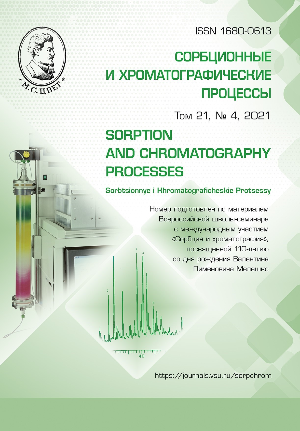Physical and chemical characteristics of a nanocomposite sorbent, nontronite/CoFe2O4
Abstract
The synthesis of nanocomposite materials with polyfunctional properties opens up a unique opportunity to obtain new sorbents. Creating composites based on nanosized ferrites and aluminosilicates is very promising since their sorption properties and catalytic and magnetic characteristics exceed those of ferrites and natural minerals. The paper shows the possibility to synthesise and use the nontronite/CoFe2O4 composite as a sorption material. Spinel was synthesised by a “soft chemistry” method, the method of citrate combustion. Nitrate-citrate synthesis allows obtaining monophase nanopowders with a homogeneous microstructure at lower temperatures and a narrow particle size distribution.
We compared the sorption capacity for the formaldehyde of natural and acid-activated nontronite, pure spinel CoFe2O4, and the nontronite/CoFe2O4 nanocomposite. The aluminosilicate was activated with a H2SO4 solution within the concentration range of 0.5-3M. Acid treatment of aluminosilicate resulted in an increase in the specific pore surface, the pore size, and pore volume, which was caused by leaching octahedral cations from the intermediate layer of the mineral.
According to the data from X-ray fluorescence analysis, the synthesised sample of cobalt ferrite was completely single-phase. CoFe2O4 particles were of irregular shape with pronounced agglomeration. The size of particles was within 30 to 185 nm. According to the data of transmission electron microscopy, the nanocomposite was comprised of nontronite particles of irregular shape, 10-50 nm in size with inclusions of individual cobalt ferrite particles 10-30 nm in size.
It was found that the sorption capacity of the composite was 17% higher than that of natural aluminosilicate, however, it was significantly inferior to that of acid-activated nontronite. The obtained adsorption isotherms were described by the Langmuir equation. Cobalt ferrite had the weakest sorption activity towards formaldehyde. The use of activated nontronite for the synthesis might allow obtaining a composite with improved sorption characteristics.
Downloads
References
Gubin S.P., Koksharov Yu.A., Kho-mutov G.B., Yurkov G.Yu., Uspekhi khimii, 2005, Vol. 74, pp. 539-574.
Lu A.-H., Salabas E.L., Schuth F., An-gew. Chem. Int. Ed., 2007, Vol. 46, рр. 1222-1244.https://doi.org/10.1002/anie.200602866
Laurent S., Forge D., Port M., Roch A. et al., Chem Rev, 2008, 108:2064-2110 Vol. 108, pp. 2064-2110. https://doi.org/10.1021/cr068445e
Faraji M., Yamini Y., Rezaee M., J. Iran. Chem. Soc., 2010, Vol. 7, pp. 1-37. https://doi.org/10.1016/j.arabjc.2011.04.012
Kydralieva K.A., Yurischeva A.A., Po-mogailo A.D., Dzhardimalieva G.I. et al. Pa-tent RU 2547496.
Tolmacheva V.V., Apyari V.V., Kochuk E.V., Dmitrenko S.G., J. of Analytical Chem-istry, 2016, Vol. 71, No 4, pp. 339-356.
Germanov E.P., Kutuschov M.V. Patent RU 2 255 800 C1.
Haicheng L., Wei C., Cheng L., Yu L., Changlong D., Microporous and Mesopo-rous Materials, 2014, Vol. 194, pp. 72-78. https://doi.org/10.1016/j.micromeso.2014.03.038
Nappini S., Magnano E., Bondino F. et al., J. Phys. Chem., 2015, Vol. 119 (45), рр. 25529-25541. https://doi.org/10.1021/acs.jpcc.5b04910
Song Q., Zhang Z.J., J. Am. Chem. Soc., 2004, Vol. 126, pp. 6164-6168.https://doi.org/10.1021/ja049931r
Tsipurskii S.I., Drits V.A., Chekin S.S. Izvestiya Akademii nauk USSR, Seriya geologicheskaya, 1978, No 10, pp. 105-113.
Juang R.-S., Lin S.-H., Tsao K.-H., Journal of Colloid and Interface Science, 2002, Vol. 254, pp. 234-241. http://dx.doi.org/10.1006/jcis.2002.8629
Noyan H., Önal M., Sarikaya Y., Food Chemistry, 2007, No 105, pp. 156-163. http://dx.doi.org/10.1016/j.foodchem.2007.03.060
Bel'chinskaya L.I., Zhuzhukin K.V., Barkov K.A., Ivkov C.A. et al., Condensed Matter and Interphases, 2020, Vol. 22, No 1, pp. 18-27.
Bel'chinskaya L.I., Khodosova N.A., Novikova L.A., Anisimov M.V. et al., Protection of Metals and Physical Chemistry of Surfaces, 2017, Vol. 53, No 5, pp. 793-800.
Köster H.M., Ehrlicher H.A., Gilg R., Clays and Clay Minerals, 1999, Vol. 34. pp. 579-599.
Hassan M.S., Abdel-Khalek, N.A., Ap-plied Clay Science, 1998, Vol. 13, pp. 99-115. http://dx.doi.org/10.1016/S0169-1317(98)00021-0
Jovanovic N., Janackovic J., Applied Clay Science, 1991, Vol. 6, pp. 59-68. http://dx.doi.org/10.1016/0169-1317(91)90010-7
Singh S., Munjal S., Khare N., Journal of Magnetism and Magnetic Materials, 2015, Vol. 386, pp. 69-73.
Bel'chinskaya L.I., Khodosova N.A., Novikova L.A., Strel'nikova O.Y. et al., Protection of Metals and Physical Chemistry of Surfaces, 2016, Vol. 52, No 4, pp. 599-606.
Bel'chinskaya L.I., Khodosova N.A., Strel'nikova O.Y., Petukhova G.A. et al., Protection of Metals and Physical Chemistry of Surfaces, 2015, Vol. 51, No 5, pp. 779-786.
The list of substances, products, pro-duction processes, domestic and natural fac-tors that are carcinogenic to humans. GN 1.1.029-98. M., Goskomsanepidnadzor Russia, 1995, 17 p.
Pallai V., Shah D.O., J. Magn. Magn. Mater., 1996, Vol. 163, pp. 243-248. https://doi.org/10.1016/S0304-8853(96)00280-6
Skomski R., J. Phys.: Condens. Matter., 2003, Vol. 15, pp. 841-896. https://doi.org/10.1088/0953-8984/15/20/202
Salunkhe A.B., Khot V.M., Thorat N.D. et al., Appl.Surf. Sci., 2013, Vol. 264, pp. 598-604. https://doi.org/10.1016/j.apsusc.2012.10.073
Liu F., Laurent S., Fattahi H. et al., Na-nomedicine. 2011, Vol. 6, No 3, pp. 519-528.https://doi.org/10.2217/nnm.11.16
JCPDC PCPDFWIN: A Windows Re-trieval/Display program for Accessing the ICDD PDF – 2 Data base, International Cen-tre for Diffraction Data. 1997.
Bergaya F., Lagaly G., Handbook of Clay Science. Developments in Clay Science 5. Amsterdam, Elsevier, 2013, 787 p.
Diaz F.C., Sanctos P.S. Studies on the Acid Activation of Brazilian Smectitic Clays. Química Nova, 2001, Vol. 24, pp. 345-353.
Tatarchuk T., Myslin M., Mironyuk I., Bououdina M. et al., Journal of Alloys and Compounds, 2020, Vol. 819, pp. 152945







